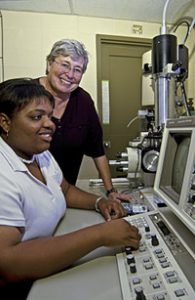Howard Hughes Interns Epitomize Possibilities at a Student-Centered Research University
by Chris Bryant

When she enrolled at UA as a freshman in 2002, Caitlin Prickett never considered she would soon begin modifying the “building blocks” that make up the genetic code of human life — pretty heady stuff for an undergraduate. But, as a participant in the University’s Howard Hughes Undergraduate Research Intern program, Prickett chemically alters these compounds, known as nucleosides, in the laboratory in attempts to better understand how cancerous tumors develop and to potentially help develop new leads in the fight against the dreaded disease.
The research intern program is funded as part of a $1.8 million Howard Hughes Medical Institute Undergraduate Science Education grant to UA in 2002; UA received a similar $1.6 million grant from the Institute in 1998.
Prickett, now a junior majoring in biology, is mentored in the research program by Dr. Kevin Shaughnessy, assistant professor of chemistry in UA’s College of Arts and Sciences. She is one of 24 students — including scholars from UA, Stillman College and Shelton State Community College — who participate and draw upon the expertise of all three campuses’ faculty.
“Although the three campuses have different missions, each faculty involved from all three campuses knows that research generates the facts, concepts, appreciations and theories that we teach,” said Dr. Martha Powell, professor and chair of biological sciences and director of the Howard Hughes Medical Institute Undergraduate Science Grant.
Eighty-five students from UA, Stillman and Shelton have participated during the past six years in this competitive program. The students receive stipends for the summer as well as additional funds to support their research and travel to regional or national conferences.
Dr. Harriett Smith-Somerville, professor of biological sciences, said her involvement in the program, in which she mentors Stillman College’s Samantha Webb, has been “energizing.” “It’s exciting to work with students who are interested, who want to be in the lab and who, like Samantha, want to know what we will do next. It gives the students an opportunity to understand exactly what research is all about. It gives them a better idea of where all the information they hear in class comes from.”
Shaughnessy said Prickett’s research has drawn from collaborations with Dr. Peter Gannett, a West Virginia University professor.
By chemically modifying nucleosides, the “building blocks” that make up DNA and RNA, the UA researchers can prepare authentic examples of structures that are produced when certain carcinogenic substances, called arylhydrazines, interact with DNA, said Shaughnessy. These substances are known to modify the structure of bases in DNA within the human body.
The West Virginia professor is interested in whether and how these chemical modifications may eventually lead to the growth of cancerous tumors, Shaughnessy said.
“Using modified nucleosides prepared by our methodology, Professor Gannett can work toward understanding how these modifications affect DNA structure and biochemistry,” Shaughnessy said. Many potentially useful antiviral and anticancer drugs are based on modified nucleosides, the UA chemistry professor said. “An efficient way to make these molecules could potentially lead to new compounds to fight cancer, AIDS, and other diseases.”
Prickett, who plans to pursue medical school following graduation, said she is a believer in the program’s benefits. “With the Howard Hughes program, I get to work with Dr. Shaughnessy on my own project, and it’s something that nobody else is doing. It’s a lot more motivating this way.”
Key aspects of the program include a class, taught by UA’s Dr. Kim Caldwell and faculty members from both UA and Stillman, called “The Language of Research,” and a two-week workshop, field trips and poster sessions where students present their work. Dr. Guy Caldwell, assistant professor of biological sciences, is the program’s activity coordinator and Dr. Gary Sloan, professor of microbiology, coordinates a weekly seminar.
Powell said the program gives participating students an extra edge in their academic careers in comparison with their peers from other universities.
“This experience enhances how competitive our students can be in the top-ranked graduate programs,” Powell said. The quality of student the program has attracted has been impressive. “We have not had a student with less than a 3.25 (grade point average) apply.”
Further Reading